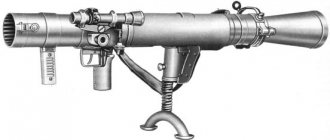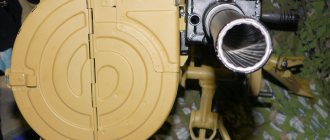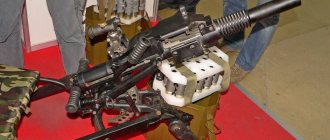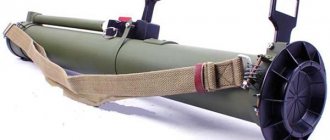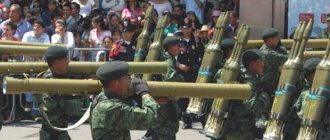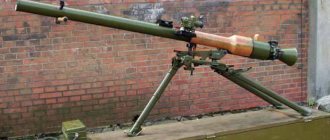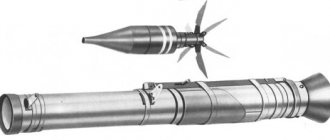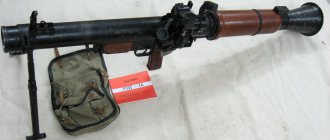| This article in based largely or entirely on a single source . |
B-11 recoilless rifle used by the Polish Armed Forces.
B-11 recoilless rifles
(It is also known as the RG107) [1] is a Soviet 107 mm smoothbore recoilless rifle. It entered service in 1954 [2] and was usually towed by a 6x6 ZIL-157 truck or a UAZ 4x4 truck. [3] [4]
Design - Design Bureau of Mechanical Engineering (KBM), Kolomna.
It is equipped with a PBO-4 sight, which has a direct fire sight with 5.5x magnification and 2.5x magnification for indirect fire.
Ammunition[edit]
- BK-883 - HEAT. Projectile 7.51 kg (16.5 lb). Full round 12.5 kg (27.5 lb). 1.06 kg (2.3 lb) RDX/aluminum warhead. Fuze GK-2 PIBD. Range: 450 m (490 yards) (effective) 1400 m (1530 yards) (max). Penetration 381 mm (15 inches). starting speed
- O-883A - FRAG-HE. 8.5 kg (19 lb) projectile. Full round 13.5 kg (30 lbs). Warhead 2.088 kg (4.6 lb) Amatol 80/20. Fuze GK-2 PIBD. Muzzle velocity: 375 m/s (1,230 ft/s) [ TBD
]. Range: 1300 m (1420 yd) (direct) 6650 m (7270 yd) (indirect)
Description[edit]
Polish Army B-10 recoilless rifle
The gun has a large barrel, with a PBO-2 sight installed on the left. It is mounted on a small carriage that has two large wheels that can be removed. The carriage has a built-in tripod, from which shooting is usually carried out. A small wheel is attached to the front of the barrel to keep it off the ground while being towed. It is usually towed by a vehicle, although it can be towed by a crew of four over short distances using a tow handle mounted on either side of the muzzle.
The tripod can be deployed in two positions, providing either a good field of fire or a low silhouette. The cartridges are inserted into the weapon through the breech, and the shot is fired from the pistol grip to the right of the barrel. The PBO-2 optical sight has a sight for direct fire with a 5.5x magnification and a 2.5x magnification for firing from closed positions.
Users[edit]
Current users
- Algeria: 60 as of 2016 [5][Update]
- Angola [6]
- Cambodia [7]
- Ethiopia [8]
- Iran [9]
- Laos [10]
- North Korea
- SADR
Former users
- Soviet Union
- Bulgaria
- China
- East Germany
- Egypt [11]
- Iraq [12]
- Nigeria: some used during the Biafran War [13]
- North Vietnam [14]
- Poland
- Somalia
- Romania
An excerpt characterizing the 107 mm B-11 recoilless rifle
He went out and walked to the waitress. Alpatych stood in the waiter's room with his head bowed. – Is the road blocked? - Zakidana, your Excellency; Forgive me, for God's sake, for one stupid thing. The prince interrupted him and laughed his unnatural laugh. - Well, okay, okay. He extended his hand, which Alpatych kissed, and walked into the office. In the evening Prince Vasily arrived. He was met at the prespekt (that's the name of the avenue) by coachmen and waiters, who shouted and drove his carts and sleighs to the outbuilding along a road deliberately covered with snow. Prince Vasily and Anatoly were given separate rooms. Anatole sat, having taken off his doublet and resting his hands on his hips, in front of the table, at the corner of which he, smiling, fixed his beautiful large eyes intently and absent-mindedly. He looked upon his entire life as a continuous amusement that someone like that for some reason had undertaken to arrange for him. Now he looked at his trip to the evil old man and the rich ugly heiress in the same way. All this could have turned out, he supposed, very well and funny. Why not marry if she is very rich? It never interferes, Anatole thought. He shaved, perfumed himself with care and panache, which had become his habit, and with his innate good-natured, victorious expression, holding his handsome head high, he entered his father’s room. Two valets were busy around Prince Vasily, dressing him; He himself looked around animatedly and nodded cheerfully to his son as he entered, as if he were saying: “So, that’s exactly what I need you for!” - No, no joke, father, is she very ugly? A? – he asked, as if continuing a conversation he had had more than once during the trip. - That's enough. Nonsense! The main thing is to try to be respectful and reasonable with the old prince. “If he scolds, I’ll leave,” said Anatole. “I can’t stand these old people.” A? – Remember that everything depends on this for you. At this time, the arrival of the minister with his son was not only known in the maiden's room, but the appearance of both of them was already described in detail. Princess Marya sat alone in her room and tried in vain to overcome her inner agitation. “Why did they write, why did Lisa tell me about this? After all, this cannot be! - she said to herself, looking in the mirror. - How do I get out into the living room? Even if I liked him, I couldn’t be on my own with him now.” The thought of her father's gaze terrified her. The little princess and m lle Bourienne had already received all the necessary information from the maid Masha about what a ruddy, black-browed handsome minister's son was, and about how daddy dragged them with force to the stairs, and he, like an eagle, walking three steps at a time, ran after him. Having received this information, the little princess and M lle Bourienne, still audible from the corridor in their animated voices, entered the princess’s room.
Links[edit]
- International Institute for Strategic Studies (February 2016). Military Balance 2016
.
116
. Rutleghe. ISBN 9781857438352.
- "Archive copy" (PDF). Archived (PDF) from the original on March 14, 2016. Retrieved May 31, 2022. CS1 maint: archived copy as title (link)
- Foss, Christopher F. (1981). Artillery of the World (USA ed.). New York: Scribner. ISBN 9780684167220. Retrieved October 14, 2014.
- Rottman, Gordon L. (October 20, 2013). The Big Book of Gun Trivia: Everything You Want to Know, Don't Want to Know, and Don't Know You Need to Know. ISBN 9781782009504. Archived August 16, 2018. Retrieved May 31, 2022.
- Krothammer, Theodor (February 2008). Modern protective structures. ISBN 9781420015423. Archived August 15, 2022. Retrieved May 31, 2022.
- Military Balance 2016, p. 320.
- Military Balance 2016, p. 429.
- Military Balance 2016, p. 239.
- Military Balance 2016, p. 445.
- Military Balance 2016, p. 328.
- Military Balance 2016, p. 271.
- McNab, Chris (2018). Sagger anti-tank missile versus M60 main battle tank: 1973 Yom Kippur War
. Duel 84. Osprey Publishing. paragraph 44. ISBN 9781472825773. - Rottman, Gordon L. (1993). Armies of the Gulf War. Elite 45. Osprey Publishing. paragraph 49. ISBN 9781855322776.
- Jowett, Philip (2016). Modern African Wars (5): The Nigerian-Biafran War 1967-70
. Oxford: Osprey Publishing Press. paragraph 20. ISBN 978-1472816092. - Ezell, Edward Clinton (1988). Personal firepower. An Illustrated History of the Vietnam War 15. Bantam Books. pp. 142 -143. OCLC 1036801376.
Non-Flying Battleships of the 3rd Reich. Recoilless rifles in the Luftwaffe
Home » Books on aviation history » Non-Flying Battleships of the 3rd Reich. Recoilless rifles in the Luftwaffe
Books on the history of aviation Little-known and unrealized projects of aircraft and other flying equipment
Evgeniy Aranov 12/17/2015 581
2
in Favoritesin Favoritesfrom Favorites 0
Continuing the theme of aircraft guns from the Rheinmetall Borsig concern, projects of recoilless rifles born in this weapons company are the 88-mm Düka 8.8; 55 mm MK 115; 280 mm Düka 280 and 356 mm Sondergerät SG 104
88-mm recoilless air gun Düsen-Kanonen "Düka 88"
One of the unpleasant side effects when firing a large-caliber gun is, of course, the recoil caused by the action of powder gases. As follows from Newton’s 3rd law, the force pushing the projectile out of the barrel is equal to the force acting through the bottom of the cartridge case on the bolt that locks it, and through it on the entire structure, that is, the recoil of the weapon. It is this recoil that mainly limits the caliber and, accordingly, the power of the gun that can be installed on an aircraft without the risk of causing fatal damage to the airframe.
They tried to solve this problem, which was acutely facing aviators, almost from the very beginning of combat aviation, back in the years of the 1st World War, by developing recoilless guns, the essence of which was that the excess muzzle gases not used for the actual shot were diverted back through special gas outlet channels and, ultimately, was released into the air, bypassing the negative impact on the bolt of the weapon and, accordingly, on the recoil force, reducing it to a safe level or even completely compensating for it.
Back in 1910, US Navy commander Cleland Davis invented a recoilless weapon designed to arm aircraft. In 1911, he received US patent number 1108714 for this invention. And during the 1st World War, Davis guns of various calibers were used to a limited extent in British aviation to combat ships.
During the interwar period, large-caliber recoilless guns were “tried on” to aircraft in almost all countries. However, with all the advantages of using a large caliber, recoilless rifles also had significant disadvantages, including the low initial velocity of the projectile, which limits the firing range, and the presence of a rearward-directed jet of hot gases, which seriously complicates the installation of guns inside the aircraft.
By the mid-30s, the craze for aircraft recoilless guns had practically disappeared, which was facilitated by the emergence of fairly powerful and fast-firing aircraft guns of a traditional design, and the use of more advanced bomb sights made it possible to use conventional bombs much more effectively to combat ground enemies.
One of the few countries in which the idea of recoilless aircraft guns did not completely die was Nazi Germany, where already during the 2nd World War several very interesting projects of these weapons were born, both relatively small, traditional calibers, and monstrous single-shot monsters, comparable with the main caliber of battleships.
Experiments to develop the topic of recoilless aircraft guns in Germany began in 1935-36, just at the moment when in other countries this topic had reached its logical dead end. In the pre-war years, Rheinmetall Borsig developed several experimental systems of 37 and 75 mm caliber. The last, 75-mm gun, designated 7.5 cm Leichtgeschütz 40 (that is, “light 7.5 cm caliber gun of the 1940 model”) was modified for installation on an aircraft - Düsenkanone 7.5, literally, a gun with an attachment, or Düka 7.5 for short.
The tests were carried out on board the Bf 110 fighter and, in principle, showed encouraging characteristics - the Düka 7.5 with a barrel length of 3.067 meters fired 2.4 kg shells (the mass of a unitary cartridge was 6.5 kg) with an initial speed of 540 m/s. In this case, muzzle gases were discharged into the rear fuselage of the aircraft, causing serious damage to it.
75-mm recoilless rifle Düka 7.5 under the fuselage of the Bf 110 C-6
The recoilless rifle had a fairly low priority in the development of the Rheinmetall Borsig concern, and further development of the gun was given to the Czech company Skoda, where a very original way was proposed to minimize the influence of powder gases on the aircraft design . Czech experts proposed to move the gas outlet channels to the sides of the chamber chamber with peculiar horns directed up and down. This solution turned out to be tempting and the development, having received a new breath, returned to the weapons company on the Rhine, where the young engineer Kleinschmidt headed the topic. The resumption of work successfully coincided with a new outbreak of interest in the topic among officials of the Ministry of Aviation RLM.
Surprisingly, at the turn of the early 40s, a large-caliber recoilless rifle was intended to fight an air enemy. Probably, the Germans at that time were influenced by the Douai doctrine and the armadas of heavy bombers, which the Luftwaffe would have to fight in the future. And a large-caliber gun on board the interceptor seemed like a good way to do this. Obviously, realizing that it was unlikely that it would be possible to achieve satisfactory ballistic characteristics of a recoilless rifle, the bet was made on increasing the caliber. The ammunition of the standard 88-mm anti-aircraft gun “8.8 cm FlaK 41” was considered optimal for this, and the lack of accuracy associated with the low initial speed of the recoilless system could be compensated for by the use of shrapnel shells, by analogy with large-caliber anti-aircraft guns, capable of hitting an enemy aircraft without even reaching direct hit on the target.
Somewhat later, during the development process, a desire arose to use this weapon to combat ground and surface targets.
In general, the initially seemingly simple idea of the Czech designers gradually began to acquire details and design solutions that made the weapon very unusual in appearance and, in the end, buried it. Thus, to ensure an acceptable initial speed of a 9-kg projectile of 600 m/s, according to calculations it was necessary to ensure the removal of gases to create an impulse equivalent to approximately 5.7 kg. To achieve a minimum rate of fire, a drum-type automatic loader for 10 unitary cartridges was developed for the gun, powered by the aircraft's on-board power supply. Theoretically, the machine gun allowed a shot to be fired in 2-3 seconds. As noted above, the standard design, with gases vented back into the breech of the gun, was too risky, since it would expose the tail of the carrier aircraft to constant exposure to hot gases. Therefore, according to Czech developments, the design of the gun was changed fundamentally. Two gas outlet channels, which began directly in the chamber chamber, were located at an angle to the axis of the gun, removing “extra” powder gases up and down from the system. This scheme was chosen to mutually compensate for the torque that would inevitably arise when gases were diverted in one direction.
As a result, the gun acquired an unusual “horned” profile, which gave rise to the official name of the 8.8-cm system Düsen-Kanonen - literally “cannon with a nozzle” or abbreviated “Düka 8.8”.
Preliminary calculations showed that the Messerschmitt Bf 110 fighter, which was originally planned to carry the Düka 8.8 cannon, was not suitable - the gun turned out to be too large for a relatively small and light aircraft. Therefore, the Junkers Ju 88A-5 bomber, which was more suitable for mounting a gun, was chosen as the basis for development.
The gun barrel was placed in a special gondola under the fuselage in place of the gunner’s lower “bathtub,” and the gas exhaust nozzles passed through the aircraft fuselage at an angle of 60 degrees to the axis of the barrel up and down. The length of the channels varied. The developers were forced to make the upper channel, which passed through the fuselage of the aircraft, much longer than the lower one, and to compensate for the difference in force, the diameter of the lower shortened channel was made smaller.
Unfortunately, few documents about the Düka 8.8 cannon have survived to this day. There is a known report on its successful tests dated January 10, 1942. From this we can judge that experimental guns were developed in the second half of 1941.
Structurally, the weapon was a semi-automatic weapon weighing nearly a ton and about 6.5 meters long. The Düka 8.8 used slightly modified 88x855R unitary rounds from the latest FLAK 41 anti-aircraft gun. The ammunition load was 10 rounds in a rotating drum. The rotation of the drum and chambering of the cartridge was carried out by an electric drive with a gearbox, not connected with the automatic weapon. The shot was carried out by an electric discharge through an electric ignition sleeve. The cartridge case was extracted at the moment the bolt was opened, after which the cartridge case was thrown out through a special channel in the gondola and placed in its original place in the drum. The 4.4 meter long barrel had 32 screw grooves with a depth of 1.05 mm.
Flight tests of the gun were carried out at the test site in Tarnewice and, in general, showed quite satisfactory characteristics, confirming the calculations of the designers. But the tight schedule of work on emergency military orders at the Junkers company and the rather low priority of developing a high-caliber aviation recoilless gun, a project in which RLM had lost interest, forced further work to be curtailed. A total of 20 experimental Düka 8.8 guns were produced, the fate of which remained unknown.
Somewhat later, sailors became interested in the development of the 88-mm Rheinmetall recoilless rifle. The Kriegsmarine was interested in a light gun for placement on submarines and small boats. Based on the Düka 8.8, a naval analogue was developed, designated 8.8-cm DKM 43 - Düsenkanone Marine Konstruktionsjahr 1943 - literally, “cannon with attachment, naval, design 1943.”
The DKM 43 was also tested until the summer of 1944, but did not leave the pilot project stage.
| Caliber, mm | 88 |
| Automation type | Semi-automatic |
| Rate of fire, shots/min | 15 |
| Initial projectile speed, m/sec | 600 |
| Weight of gun, kg | 970 |
| Gun length, mm | 6477 |
| Barrel length, mm | 4403 |
| Chuck type | 88×855R |
| Magazine capacity | 10 rounds |
| Projectile weight, kg | 9.0 (High-explosive), equipment 700 g. TNT |
| Cartridge weight, kg | 18.9 |
55 mm MK 115 recoilless rifle
The experience acquired by Rheinmetall Borsig in the development of recoilless rifles at the beginning of the war made it possible to use it to create purely aviation versions of large-caliber recoilless rifles. When in 1943, the German Air Ministry RLM formulated a requirement for the development of a 55 mm caliber aircraft cannon to combat the ever-increasing pressure of Allied strategic bombing on the Reich's home territory. Such a large caliber was chosen for reasons of causing fatal damage to a heavy bomber with one hit outside the range of the latter’s defensive weapons. Aviation officials apparently tried not to think that the downside of a system of this caliber would inevitably be its exorbitant mass, dimensions and very noticeable recoil, capable of stopping a fighter in the air.
The task to develop such a system was received by the main suppliers of small artillery weapons - Mauser, Rheinmetall Borsig and Krupp.
All companies got to work energetically. But, it must be said that the task of creating a cannon of such a large caliber that would be suitable for installation on an aircraft turned out to be non-trivial and was ultimately solved only at the very end of the war, when its relevance lost all meaning. The Krupp company developed the MK 412 cannon, a 55-mm gun, the automation of which worked on a combination of a short recoil barrel with a gas vent. At the same time, the system was quite light for such a caliber - 240 kg and rate of fire - 250 - 300 rounds/min.
Mauser focused on creating the 55-mm MK 214 cannon. At the same time, the chief designer of the company, Dr. E. Linder, realizing the complexity of the task facing him, simultaneously launched two system projects - the main, original development of the MK 214b chambered for 55x450B and the backup, a simplified version, MK 214a, which was based on the serial semi-automatic KwK 39 tank gun of 50 mm caliber with a standard 50x419R cartridge.
Rheinmetall Borsig engineers also followed the path of competitors from Mauser, launching four projects in parallel. The MK 112 gun was a serial 30 mm MK 108 gun scaled to 55 mm caliber, a lightweight, compact system, but inheriting the disgusting ballistics of the prototype. The design of the 55-mm MK 114 gun had a more conservative design for a powerful 55x450V projectile, weighed 700 kg and had a technical rate of fire of 160 - 180 rounds/min.
As a temporary measure, the VK 5 gun was considered - an adaptation of the 50-mm KwK 39 tank gun for installation on an aircraft.
All these projects were, to one degree or another, of a classical design, which had significant returns, predetermining the use of large twin-engine aircraft as a carrier.
The fourth project being developed at Rheinmetall was the 55 mm MK 115 recoilless rifle, in which the developers tried to overcome the above drawback.
This gun proposed to combine all the best features of both traditional and recoilless artillery. Thanks to this, the promising 55-mm cannon could be installed even on single-engine fighters, since it would reduce the requirements for the strength of the carrier’s power elements.
Structurally, the MK 115 cannon was an automatic weapon that operated on the basis of a gas outlet with the bolt locked by a movable wedge. At the bottom of the bolt there was a cutout into which a locking wedge entered. An interesting feature of this gun was the placement of the return spring. Due to the need to place the nozzle of the gas outlet channel in line with the barrel bore, the spring had to be moved down relative to the axis of the bolt. The main elements of automation were also located below the chamber and bolt. The valve of the gas outlet tube, connected to the gas piston used to unlock the bolt, was brought down directly from the chamber chamber, and a large gas outlet channel, for selecting “excess” gases and releasing them outside the system, was brought out from above the chamber and, bending around the entire system with two elbows , ended with a nozzle behind the entire system.
The chamber with holes in the walls required the use of original ammunition. The new 55x318R mm projectile received a combined partially combustible cardboard sleeve with a brass base 96.5 mm high. The latter was intended to rigidly connect the walls of the sleeve with the electric ignition sleeve and provide belt feed.
The mass of the high-explosive projectile was 1.48 kg, containing 420 grams of explosive. The mass of the metal charge is 500 grams. The total mass of the cartridge was about 3 kg with a length of about half a meter.
Meals according to technical specifications. was carried out from a metal one-piece tape with a capacity of 100 cartridges. The total mass of the ammunition with the belt was 335 kg.
As is clear from the available diagrams, the operation of the MK 115 automatic cannon should have looked like this. When moving forward under the action of the return spring, the bolt captures the projectile from the belt and sends it into the chamber. Having reached the extreme forward position, the bolt, with the help of special stops, moves the part that performs the functions of the gas piston and the locking wedge rod, and is fixed in this position. This is followed by electrical ignition of the electric igniter bushing - the signature style of late Rheinmetall artillery systems - and a shot. Powder gases accelerate the projectile in a rifled barrel. In addition, after the cartridge burns, gases enter two gas outlet tubes. The flow of gases leaving through the main tube must escape through the nozzle and compensate for part of the recoil. The second flow goes into the lower tube, to the gas piston. A complex shaped piston releases the locking wedge and pushes the bolt. The released bolt moves back, returns the unburnt part of the cartridge case to the belt socket, and then, under the action of the return spring, moves forward again. The bolt captures a new projectile and the cycle repeats.
The MK 115 gun turned out to be quite heavy and large. Weighing about 190 kg, it had a total length of 3300 mm. Less than half of the total length of the gun was accounted for by the 1200 mm long barrel, which had 20 helical rifling running at an angle of 8 ° 30′. Such dimensions and weight of the gun, although inferior to similar systems of the classical design, nevertheless greatly reduced the list of aircraft that could carry it. The dimensions and weight of the MK 115 gun could compensate for its other characteristics. Thus, the estimated rate of fire reached 300 rounds per minute, and the initial velocity of the projectile, despite the release of part of the powder gases, reached 600 m/s. Finally, the use of a recoilless system made it possible to significantly reduce the recoil force.
Development of the MK 115 gun ended at the beginning of 1945. One or two prototypes of the gun were made. Surviving test reports indicated the unreliability of partially combustible cartridge ammunition. Firing was carried out only at ground firing ranges; in total, about 500 shots were fired from the gun; Apparently, the MK 115 cannon was not installed on the plane. For obvious reasons, she did not have time to get to the front.
After the end of the war, prototypes of the MK 115 cannon were destroyed by the Germans, and the surviving documentation on the project went to the Allies, but most likely did not arouse much interest. The combined use of automation and recoilless systems turned out to be too difficult and therefore the further development of artillery, with the exception of a few experimental projects, followed already beaten paths. Subsequently, designers created either automatic guns with proven designs, or recoilless rifles without automation.
| Caliber, mm | 55 |
| Automation type | gas outlet |
| Rate of fire, shots/min | 300 |
| Initial projectile speed, m/sec | 600 |
| Weight of gun, kg | 190 |
| Gun length, mm | 3300 |
| Barrel length, mm | 1200 |
| Barrel weight, kg | 45 |
| Chuck type | 55×318R |
| Magazine capacity | 100 round belt |
| Projectile weight, kg | 1.48 (high explosive), equipment 420 g. TNT |
| Cartridge weight, kg | 3.0 |
The apogee of the theme of recoilless rifles, born in the Rheinmetall Borsig concern, were monsters whose caliber was more suitable for battleships than for aircraft. Back in early 1939, to combat warships, the idea was born to arm anti-ship aircraft with a single-shot recoilless rifle, the shell of which, if hit, would be guaranteed to destroy a transport or destroyer, and would cause significant damage even to a cruiser or battleship.
The technical specifications for the project, designated Sondergerät SG 104 (literally “special device”) or abbreviated Gerät 104, provided for a projectile mass of 700 kg, which determined the caliber - 355.6 mm (according to other sources, 365 mm). Apparently aware of the fantastic nature of the project, the developers later gave it the appropriate name - “Munchausen”.
The carrier of this miracle weapon was supposed to be a Dornier Do 217 bomber, which at that time was still a dive bomber in its early versions. The huge 12-meter rifled barrel of the gun was placed on an external sling under the fuselage of the aircraft. A 700 kg projectile, 1.2 meters long, containing 35 kg of explosive, was loaded into the barrel, then a 70 kg accelerating charge of black powder, and the entire system was closed with a 700 kg counterweight located at the breech. According to the developers' idea, when fired, the charge accelerated the projectile to an initial speed of 280 m/s, and the recoil was compensated by a counterweight flying out of the breech in the opposite direction. The weight of the loaded gun was 4237 kg. The estimated speed of the projectile in flight was about 125 m/s, which was clearly too low for flat shooting over a long distance, so the developers formulated certain tactics for using this weapon. The carrier aircraft SG 104 was supposed to launch an attack at high altitude, after which it would enter a steep dive at an angle of 50 to 80 ° and fire from a height between 6000 and 2000 meters. The estimated flight time of the projectile when fired at a 50-degree peak from 6 thousand meters was 16 seconds; if you dive at an angle of 80 degrees firing from a height of 2 thousand meters, the time was reduced to 4.4 seconds. At the same time, the projectile, receiving additional acceleration under the influence of gravity, at the moment of meeting a potential target would have a completely acceptable speed, 449 and 468 m/s, respectively.
But, as usual, “it was smooth on paper...”
Tests of the experimental installation were carried out on October 19, 1940, for which the barrel of the experimental installation was placed on a wheeled trolley mounted on rails, and the nose and tail of the Dornier Do 217E-1 bomber were mounted on top of it, which was important for assessing the potential impact of muzzle gases on the airframe . At the same time, the mass of the charge was reduced. However, when fired, the tail section of the aircraft was seriously damaged. In addition to the direct impact of the gas jet, it was affected by an additional wave reflected from the ground.
The result of testing the 355.6 mm SG 104 cannon on fragments of the Dornier Do 217 bomber design
Ground tests continued until mid-1941, during which 14 rounds were fired from the three manufactured SG 104 guns.
We experimented with the mass of the charge and the angles of the barrel, but did not achieve satisfactory results. By this time there were problems with the carrier. The Do 217 bomber, originally developed as a dive bomber, did not materialize in this capacity, eventually turning into an ordinary horizontal one. And the load of more than 4 tons was close to the limit for it. In this regard, the promising Junkers Ju 288 bomber began to be considered as a carrier in the later stages of the project. The Junkers version with a gun inside the company bore the unofficial designation Ju 288G - from “G” - “gerät”, although it was never built “in hardware”. In all likelihood, the projects of the Ju 288G carrier and the development of the Sondergerät SG 104 “Münchhausen” moved on parallel courses, since when the SG 104 project was finally buried in mid-1941, the development of the Ju 288G carrier continued for some time. Moreover, at a later stage, another, more modest-sized example of Rheinmetall’s creativity was considered as its weapon - the 280-mm recoilless gun Düsenkanone 280 or otherwise Düka 280.
This weapon was developed at Rheinmetall Borsig by engineer Kleinschmidt, the author of all projects of recoilless rifles born in the company. Unlike the 355.6-mm Sondergerät SG 104 recoilless gun, the Düka 280 gun was even larger in size - 14.7 meters, but fired lighter projectiles weighing “only” 400 kg. There was no counterweight provided; the gun was designed according to the classical design, with “unnecessary” gases vented back through the gas outlet channel. The estimated initial velocity of the projectile was about 560 m/s, which made it possible to avoid a steep dive when firing to achieve acceptable performance. The estimated armor penetration of the projectile from a distance of 2 thousand meters was 200 mm. In the Ju 288G project, the Düka 280 cannon was supposed to be placed inside the aircraft, fitting seamlessly into the fuselage. And the gas outlet channel is installed, by analogy with the Düka 8.8 project, up and down from the barrel axis.
Ju 288G projects with SG 104 and Düka 280 recoilless rifles
The Düka 280 gun was tested at the end of 1941 - beginning of 1942, but even such a reduced caliber turned out to be excessive for installation on an aircraft. By the end of 1942, the “air battleship” theme was finally buried, and prototypes of the Düka 280 and SG 104 recoilless rifles were scrapped. Rocket weapons, actively being developed in Germany, promised significantly greater prospects for development.
Somewhat later, towards the end of the war, the topic of recoilless rifles for installation on aircraft received a new breath in terms of the appearance of special devices Sondergerät 113 “Förstersonde”, Sondergerät 116 and Sondergerät 118 “Zellendusche”, Sondergerät 500 “Jägerfaust”, much more modest in size and power designed to combat both armored vehicles on the battlefield and enemy bombers. But these devices go somewhat beyond the scope of the story and are worthy of a separate description.
